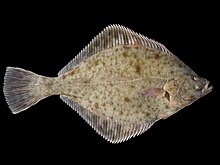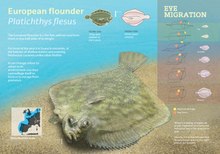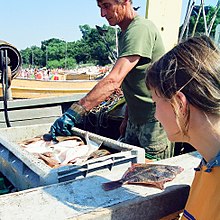European flounder
| European flounder | |
|---|---|

| |

| |
| Scientific classification | |
| Domain: | Eukaryota |
| Kingdom: | Animalia |
| Phylum: | Chordata |
| Class: | Actinopterygii |
| Order: | Pleuronectiformes |
| Family: | Pleuronectidae |
| Genus: | Platichthys |
| Species: | P. flesus
|
| Binomial name | |
| Platichthys flesus | |
| Synonyms[2] | |
| |
The European flounder (Platichthys flesus) is a
The European flounder is oval in shape and is usually right-eyed. It normally grows about 30 cm in length, although lengths of up to 60 cm have been recorded. The upper surface is usually dull brown or olive in colour with reddish spots and brown blotches and this fish can change colour to suit its background, providing an effective
Description
The European flounder is a flatfish with an oval-shaped body with a width about half its length. The maximum recorded length is 60 centimetres (24 in) and the maximum recorded weight 2.93 kilograms (6.5 lb). However, a more usual mature length is about 50 centimetres (20 in).[3]
The fish is flattened laterally and swims and rests on one side. During development, its eyes usually migrate to the right side of the fish and what appears to be its upper surface is in reality its right side. In about thirty percent of individuals, its eyes move to the left and the left side becomes uppermost. The fish has a small mouth at the end of its bluntly pointed snout. The upper surface is fawn, olive green or pale brown with spots and larger patches of darker brown and some irregular reddish spots. The under surface is opaque pearly-white giving the fish its common name of "white fluke". The
Distribution and habitat
The European flounder is native to the north eastern Atlantic Ocean and the Mediterranean Sea. The range extends from the
The European flounder can also be found in
Biology

The European flounder lives and feeds on the seabed and in the waters immediately above. It is mainly nocturnal and during the day rests on the sea floor, semi-submerging itself in the
The European flounder leaves freshwater in the autumn and can often be caught in estuaries when the first frosts occur. Then the fish move into deeper water for the winter. In the spring it migrates to the spawning grounds, travelling at three to four miles (five to seven kilometres) per day and not eating en route. Spawning takes place between January to perhaps as late as July,[5] being later in more northerly latitudes. The female releases about a million eggs which are lighter than water. The male releases sperm which also floats and both eggs and sperm rise to the surface. Here the eggs are fertilised and hatch after six to eleven days depending on the water temperature. The developing larvae are planktonic and drift towards the coast and use selective tidal stream transport to migrate into estuaries and rivers.[6][7] Juvenile flounders live in shallow waters, estuaries and rivers commonly at low salinity conditions. Flounders become mature when still small, the males when they measure 11.5 centimetres (4.5 in) and the females when they measure 18 cm (7 in).[4] The European flounder sometimes hybridises with European plaice (Pleuronectes platessa) and, particularly in the western Baltic Sea, the hybrid is common.[8] In the Baltic Sea, populations of European flounder are known to breed in shallow waters rather than the deep water typical of the species; these populations are now known to be a distinct species, the Baltic flounder (P. solemdali). The Baltic flounder has steadily outcompeted the European flounder over the past 5,000 years due to a combination of natural and anthropogenic environmental changes.[9][10]
Human interactions

The European flounder is used for human consumption but is not so highly esteemed as the European plaice or common sole (Solea solea).[4] The most important fisheries are in the Baltic Sea and the waters around the Netherlands and Denmark. In 2010, the total world catch was about nineteen thousand tonnes, mostly caught by bottom trawling. The fish is marketed fresh and frozen and can be fried, boiled, steamed, baked or microwaved.[8]
It has been found that male European flounders living in polluted estuaries may show signs of excess exposure to
Status
The European flounder is assessed by the
References
- ^ . Retrieved 18 November 2021.
- ^ a b Bailly, Nicolas (2013). "Platichthys flesus (Linnaeus, 1758)". WoRMS. World Register of Marine Species. Retrieved 2013-08-31.
- ^ a b c Froese, Rainer; Pauly, Daniel (eds.) (2018). "Platichthys flesus " in FishBase. February 2018 version.
- ^ ASIN B00ABHEN6Y.
- PMID 33426248. 101196.
- ^ Bos, Arthur R. (1999). "Tidal transport of flounder larvae (Pleuronectes flesus) in the River Elbe, Germany". Archive of Fishery and Marine Research. 47 (1): 47–60.
- hdl:2066/35752.
- ^ a b Fisheries and Aquaculture Department. "Platichthys flesus (Linnaeus, 1758)". Species fact sheets. Food and Agriculture Organization of the United Nations. Retrieved 2013-09-01.
- ISSN 2296-7745.
- ^ PMID 30828373.
- S2CID 84255505.
External links
 Media related to Platichthys flesus at Wikimedia Commons
Media related to Platichthys flesus at Wikimedia Commons Data related to Platichthys flesus at Wikispecies
Data related to Platichthys flesus at Wikispecies- Photos of European flounder on Sealife Collection

